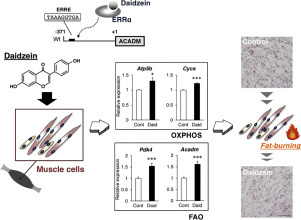The Journal of Nutritional Biochemistry ( IF 5.6 ) Pub Date : 2019-12-16 , DOI: 10.1016/j.jnutbio.2019.108315 Kanano Kitamura 1 , Jane Surya Erlangga 1 , Sakuka Tsukamoto 1 , Yuri Sakamoto 2 , Hideaki Mabashi-Asazuma 3 , Kaoruko Iida 3

|
Estrogen-related receptor (ERR)α regulates genes involved in fatty acid oxidation (FAO) and oxidative phosphorylation (OXPHOS) in muscle. The soy isoflavone daidzein was reported to be a putative ERRα activator, but little is known about its effects on gene expression and FA metabolism. This study aimed to clarify whether daidzein affects FAO- and OXPHOS-related genes thereby modulating intracellular FA metabolism in muscle cells. For this purpose, we used the C2C12 murine muscle cell line. ERRα-expressing C2C12 myotubes were treated with 50 μM daidzein, and gene expression was examined. The expression of FAO genes such as pyruvate dehydrogenase kinase 4 (Pdk4) and acyl-coenzyme A dehydrogenase (Acadm) and that of OXPHOS genes such as ATP synthase F1 subunit beta (Atp5b) and cytochrome c (Cycs) was significantly increased by daidzein, and these effects were partially blocked by an ERRα inhibitor. Using a reporter assay, we showed that daidzein enhanced the promoter activity of these genes and that ERRα responsive elements in the promoter region were necessary for the action of daidzein. Finally, daidzein significantly decreased lipid accumulation in C2C12 myotubes associated with increased oxygen consumption. In conclusion, daidzein decreases lipid deposition in muscle cells by regulating the expression of genes related to FAO and OXPHOS via an ERRα-associated pathway at least in part. These results suggest that daidzein would be a beneficial tool to protect against various diseases caused by muscle lipotoxicity.
中文翻译:

黄豆苷元通过雌激素相关受体α途径促进氧化磷酸化和脂肪酸氧化相关基因的表达,从而减少肌肉细胞中脂质的积累。
雌激素相关受体(ERR)α调节肌肉中涉及脂肪酸氧化(FAO)和氧化磷酸化(OXPHOS)的基因。据报道,大豆异黄酮黄豆苷元是一种推定的ERRα激活剂,但对其基因表达和FA代谢的影响知之甚少。这项研究旨在阐明黄豆苷元是否会影响FAO和OXPHOS相关基因,从而调节肌细胞中细胞内FA代谢。为此,我们使用了C2C12鼠肌细胞系。用50μM大豆苷元处理表达ERRα的C2C12肌管,并检查基因表达。丙酮酸脱氢酶激酶4(Pdk4)和酰基辅酶A脱氢酶(Acadm)等FAO基因的表达和ATP合酶F1亚基β(Atp5b)等OXPHOS基因的表达。大豆苷元显着增加)和细胞色素c(Cycs)的活性,并且这些作用被ERRα抑制剂部分阻止。使用报告基因分析,我们表明黄豆苷元增强了这些基因的启动子活性,并且黄豆苷元的作用在启动子区域中的ERRα响应元件是必需的。最后,大豆苷元显着降低了C2C12肌管中的脂质蓄积,这与氧气消耗增加有关。总之,黄豆苷元至少部分通过ERRα相关途径调节与FAO和OXPHOS相关的基因的表达,从而减少肌肉细胞中的脂质沉积。这些结果表明,大豆苷元将是预防由肌肉脂毒性引起的各种疾病的有益工具。



























 京公网安备 11010802027423号
京公网安备 11010802027423号